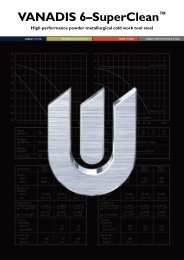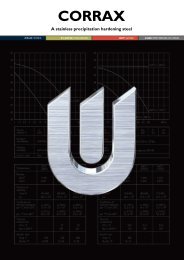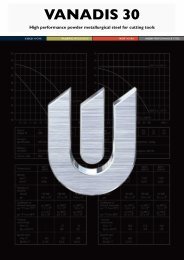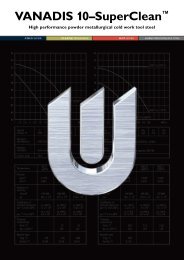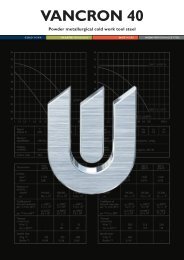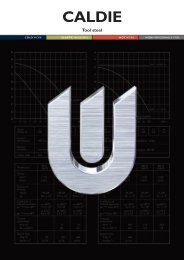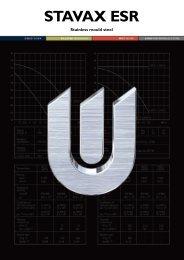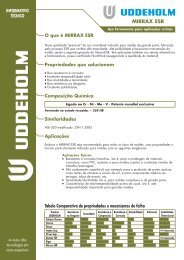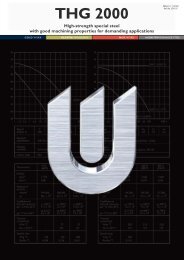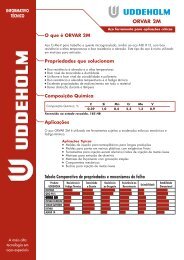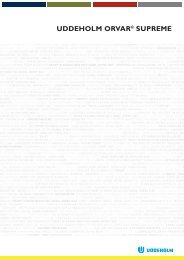RIGOR - Uddeholm
RIGOR - Uddeholm
RIGOR - Uddeholm
You also want an ePaper? Increase the reach of your titles
YUMPU automatically turns print PDFs into web optimized ePapers that Google loves.
<strong>RIGOR</strong><br />
DIMENSIONAL CHANGES<br />
DURING HARDENING<br />
Sample plate, 100 x 100 x 25 mm, 4" x 4" x 1".<br />
Width Length Thickness<br />
% % %<br />
Oil hardening from min. –0,10 –0,02<br />
960°C (1760°F) max. –0,05 +0,06 –0,05<br />
Martempering<br />
from 960°C min. +0,04 +0,06<br />
(1760°F) max. +0,05 +0,08 +0,04<br />
Air hardening from min. +0,08 +0,13<br />
960°C (1760°F) max. +0,14 +0,15 +0,04<br />
DIMENSIONAL CHANGES<br />
DURING TEMPERING<br />
Dimensional change, %<br />
+0,20<br />
+0,16<br />
+0,12<br />
+0,08<br />
+0,04<br />
0<br />
–0,04<br />
–0,08<br />
–0,12<br />
–0,16<br />
–0,20<br />
100 200 300 400 500 600 700°C<br />
200 400 600 800 1000 1200°F<br />
Tempering temperature<br />
Note: The dimensional changes on hardening and<br />
tempering should be added together.<br />
SUB-ZERO TREATMENT AND AGING<br />
Pieces requiring maximum dimensional stability<br />
should be sub-zero and/or artificially aged as<br />
volume changes may arise in the course of time.<br />
This applies, for example, to measuring tools like<br />
gauges and certain structural components.<br />
Sub-zero treatment<br />
Immediately after quenching, the piece should be<br />
sub-zero refrigerated to between –40 and –80°C<br />
(between –40 and –110°F) followed by tempering<br />
or aging. Sub-zero refrigeration for 2–3 hours will<br />
give a hardness increase of 1–3 HRC. Avoid intricate<br />
shapes as there is a risk of cracking.<br />
Aging<br />
Tempering after quenching is replaced by aging<br />
at 110–140°C (230–285°F). Holding time 25–<br />
100 hours.<br />
NITRIDING<br />
Nitriding will give a hard diffused surface layer<br />
which is very resistant to wear and erosion, and<br />
also increases corrosion resistance. Nitriding in<br />
ammonia gas at a temperature of 525°C (975°F)<br />
gives a surface hardness of approx. 1000 HV 1<br />
.<br />
Nitriding<br />
Depth of case,<br />
temperature Nitriding time approx.<br />
°C °F hours mm in.<br />
525 980 20 0,2 0,008<br />
525 980 30 0,3 0,012<br />
525 980 60 0,4 0,016<br />
2 hours nitrocarburizing treatment at 570°C (1060°F)<br />
gives a surface hardness of approx. 900 HV 1<br />
. The<br />
case depth having this hardness will be 10–20 µm<br />
(0,0004–0,0008").<br />
This tool was made from <strong>RIGOR</strong>. 3 million parts were<br />
manufactured before the tool was reground.<br />
5



